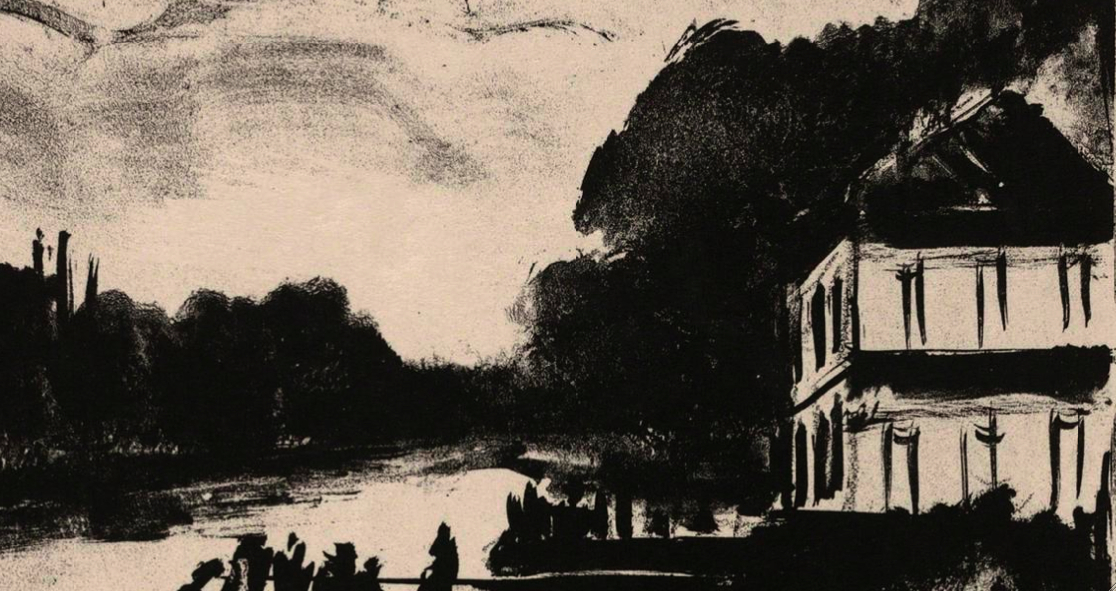
[FLOOR]
In the foyer: a walnut floor. The cracks near the door create a triangular pattern. There are water scars at the foot of the stairs.
I scrape cobwebs from the baseboards with a dull knife.
Church oak, in folklore, bleeds every evening. And red oak, I notice, creaks quite modestly—at least in the rear hallway, early in the afternoon.
The object discovered beneath the floorboards, often something of the mother’s, is a separate affair, a ghastlier matter for later on.
I prefer steel wool and turpentine for certain stains.
On the stairs: axminster, six years old.
I stand on the landing—in an attitude of embarrassment—and then retreat to our room.
On the floor of the bedchamber or the corridor or the inner parlor—in Thornton, during the war—the father dressed the daughters for their coffins.
Church oak, burning, recalls the sound of a stricken man. Or, by other accounts, the sound of a burning animal or a coffin bell.
I clean the ceilings with rags—remnants of bedsheets, for the most part, and sleeves torn from white shirts—or with a wire brush.
In the guest room: Wilton broadloom, cut pile. A wooden pistol—in the form of a horse—sits in the far corner. Perhaps these are carpet beetles vanishing beneath the cabinet.
I count footsteps in the hall.
In the country house—outside Lawton or Marion—they measured the dimensions of a body in repose, a body in distress, a body in agony, and marked the floor accordingly.
Some Colonial floor plans trace the progress of the body—or, put a different way, the path of the wife from room to room to room, and then down the stairs, and from the stairs to the door.
[CELLAR and ATTIC]
In the cellar: a pull saw and a hasp, a jack plane, a wrecking bar, and a claw hammer. A tin contains a cap screw and a razor blade. A jar contains the remains of a carpet beetle.
I dismantle the chairs and place all the parts in a crate. I station the broom beside the garden spade.
The killer in the cellar, in folklore, is discovered by a mute child. The prisoner in the cellar survives a fire or a storm—but is later mauled by wolves.
There were fleas last year, and squirrels the year before that.
The foundation plan of the Burrows house, on Market street, in Durham, Pennsylvania—built 1875; sold 1878; destroyed, by flood, 1914—indicates, upper right, a furnace room, divided in two, and a disappearing staircase.
In the attic: a stump doll, a child’s rifle, a wig on a wooden peg. Grandmother’s hat-stands—the initials in cursive—are set out on a metal ledge. A suitcase contains five nightdresses and a carriage bolt.
There is a mark on the doorpost, in blue ink, forty-one inches from the floor.
Mannikins—Mary Casket and John Coffin—would hang from the rafters in Colonial attics. Dollhouses, in Victorian attics, were sometimes arranged to form foreign towns—and, as it turns out, to capture bats.
I place the poison in each corner. I find the bodies behind the door—that morning or afternoon, or by the end of the week.
The cross section of the grimes house, on Oak Road, in Thornton, Pennsylvania—built 1906; sold 1938; torn down 1939—indicates, among other things, an attic door, ajar, and blackout at a ridge vent.
[ROOF]
The roof often appears a peculiar blue. At this distance, anyway—from the lawn and the walk. The dormers are somewhat darker.
Your standard roofing nail, nine gauge or ten, barbed, lands on the awning or on the garden path.
Slating: copper wire. Shingle: cut iron or steel.
Is it true that the mansard roof was named for the form of Mansart’s coffin?
But now we are north of the boy.
Poor boys fall from chimneys only in the morning, according to that old saying—just as a gentleman drowns only at night.
Either way, a windstorm next August will carry off the neighbor’s weathervane.
I paint the eaves and doorframes every five years. I have twice replaced the flashing at the ridge.
The shakes are cedar or pine, hand-split and stained. Pitch: 12/12. The gambrel roof was named for the gambrel stick—bent like a horse’s leg, and from which butchers would hang dead animals.
Lightning strikes the ladder, several rungs down. My father’s house, on New Street, in Bethlehem, Pennsylvania—which I visited as a child, in 1969—was a brown Colonial with four columns, dentil molding, and a widow’s walk.
The cornice vents attract various insects—crickets, termites, flies.
Flat wire: one foot square. Single bead: soldered.
And now we find a cat’s tail near the downspout.
The gable roof was named for the gable wall—brick, in this case, with an ornament on the door.
From above, the man on the roof—just east of the dormers; prone—may appear a branch or a pitchfork, or perhaps a tiny gap in the valley.

